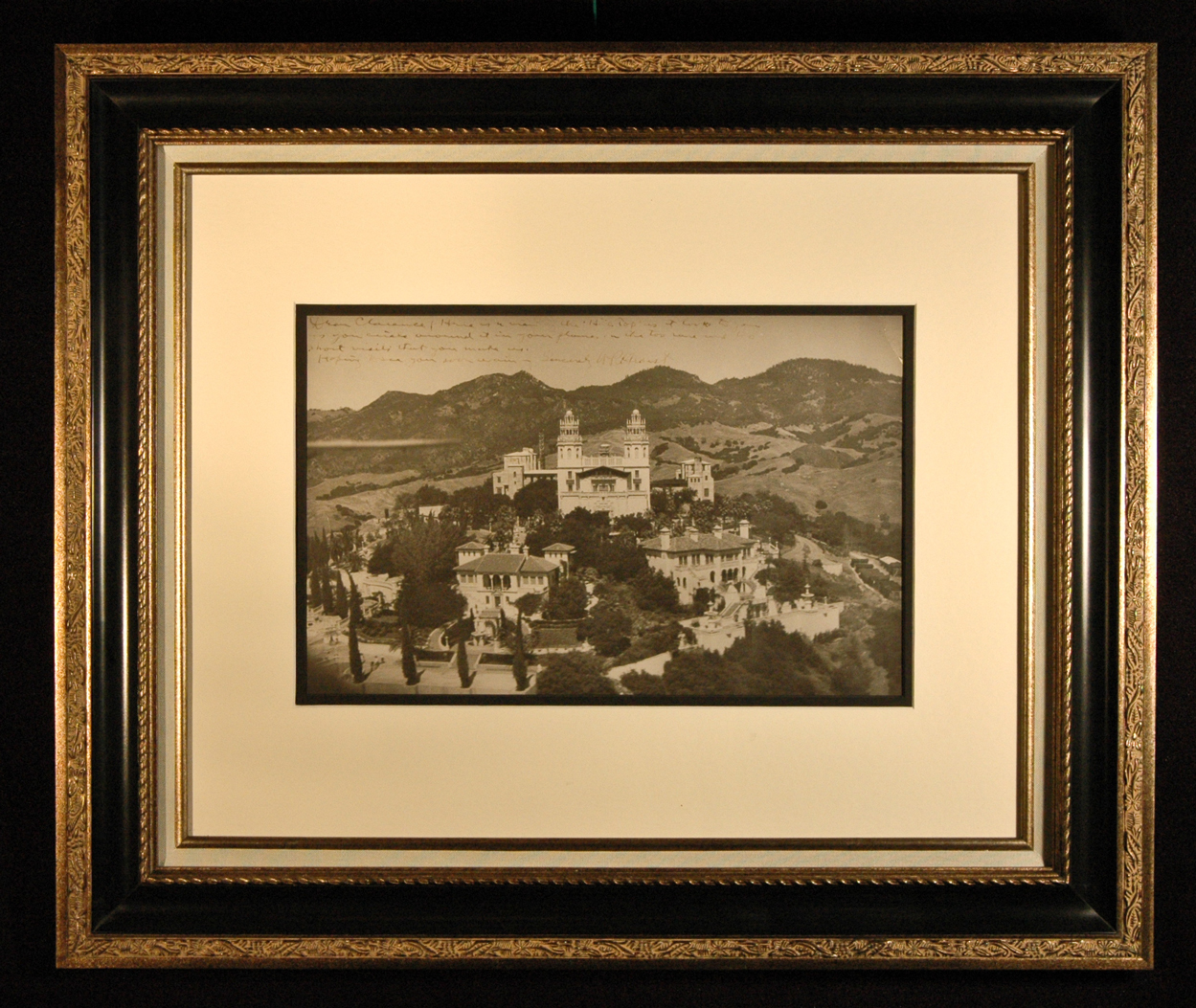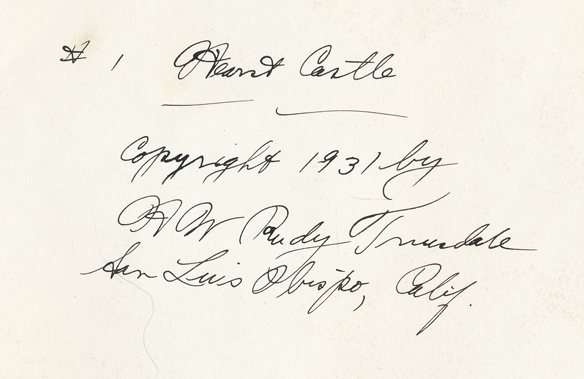William Randolph Hearst
William Randolph Hearst
William Randolph Hearst Inscribed Photo of Hearst Castle - 1931
Beautifully framed 22″ x 26″ black-and-white aerial photograph of Hearst Castle taken in 1931 by H.W. Rudy Truesdale, San Luis Obispo, California. Slight tear in upper right, otherwise in very good condition. Inscribed and signed by W.R. Hearst, in full:
“Dear Clarence: Here is a view of the “Hill Top” as it looks to you as you circle around in your plane, on the too rare and too short visits that you make us. Hoping to see you soon again – W.R. Hearst”
In researching the provenance of this photograph, we found three prominent “Clarence’s” in Hearst’s life: Clarence Darrow, Hearst’s general counsel, who was also the famed defense attorney in the 1925 Scopes “Monkey” Trial; Clarence Lindner, editor of Hearst’s San Francisco Examiner; and Clarence Shearn, another Hearst attorney. Though it’s possible it was another Clarence altogether, it was quite probably one of the three just mentioned; whoever it was had his own plane when visiting Hearst Castle, which had its own private landing strip.
Hearst Castle is the palatial estate built by Hearst over a period of 28 years, from 1919 to 1947, designed by San Francisco architect Julia Morgan. It is located near San Simeon, California, on a stunning hill overlooking the Pacific Ocean, halfway between Los Angeles and San Francisco. Donated by the Hearst Corporation to the state of California in 1957, it is now a State Historical Monument and a National Historic Landmark, open for public tours. Hearst formally named the estate La Cuesta Encantada (“The Enchanted Hill”), but he usually just called it “the Ranch”. The castle and grounds are also sometimes referred to as “San Simeon,” for the nearby town.
The mammoth estate is a pastiche of historic architectural styles that Hearst admired in his travels around Europe. For example, the main house is modeled after a 16th century Spanish cathedral, while the outdoor swimming pool features an ancient Roman temple front transported wholesale from Europe and reconstructed at the site. Hearst furnished the estate with truckloads of art, antiques, and even whole ceilings that he acquired in their entirety from Europe and Egypt.
Comprising over 90,000 square feet, Hearst Castle features 56 bedrooms, 61 bathrooms, 19 sitting rooms, 127 acres of gardens, indoor and outdoor swimming pools, tennis courts, a movie theater, an airfield, and, at the time, the world’s largest private zoo. Zebras and other exotic animals still roam the grounds.
Invitations to Hearst Castle were highly coveted during its heyday in the 1920s and ’30s. The Hollywood and political elite often visited, usually flying into the estate’s airfield or taking a private Hearst-owned train car from Los Angeles. Charlie Chaplin, Cary Grant, the Marx Brothers, Charles Lindbergh, Joan Crawford, Calvin Coolidge, William P. Clark, Franklin Roosevelt, and Winston Churchill were among Hearst’s A-list guests. While guests were expected to attend the formal dinners each evening, they were normally left to their own devices during the day while Hearst directed his business affairs. Since “the Ranch” had so many facilities, guests were rarely at a loss for things to do. The estate’s theater usually screened films from Hearst’s own movie studio, Cosmopolitan Productions. Hearst Castle became so famous that it was caricatured in the 1941 Orson Welles film Citizen Kane as Charles Foster Kane’s “Xanadu.”
This informative and full-color map of Hearst Castle can be useful in identifying some of the buildings in the photograph.
WILLIAM RANDOLPH HEARST I (1863 -1951) was an American newspaper magnate and leading newspaper publisher. The son of self-made millionaire George Hearst, he became aware that his father received a northern California newspaper, The San Francisco Examiner, as payment of a gambling debt. Still a student at Harvard, he asked his father to give him the newspaper to run. In 1887, he became the paper’s publisher and devoted long hours and much money to making it a success. Crusading for civic improvement and exposing municipal corruption, he greatly increased the paper’s circulation. He was twice elected to the U.S. House of Representatives.
All Vintage Memorabilia autographs are unconditionally guaranteed to be genuine. This guarantee applies to refund of the purchase price, and is without time limit to the original purchaser. A written and signed Guarantee to that effect accompanies each item we sell.



